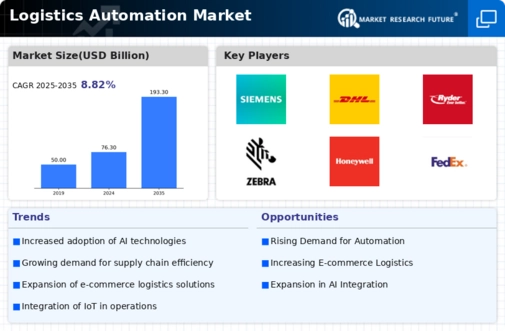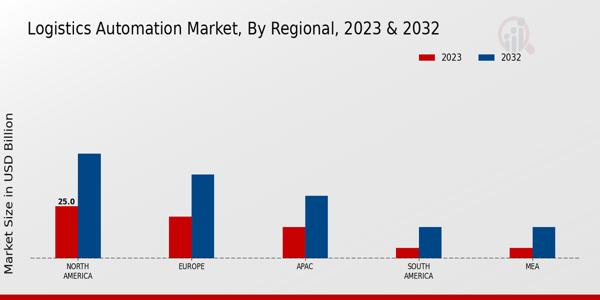Focus on Supply Chain Resilience
The focus on supply chain resilience is becoming a critical driver for the Logistics Automation Market. Recent disruptions in global supply chains have highlighted the need for robust and adaptable logistics solutions. Companies are increasingly investing in automation to enhance their supply chain resilience, enabling them to respond swiftly to unforeseen challenges. The logistics automation market is projected to benefit from this trend, as businesses seek to build more resilient operations through technology. By automating processes, firms can improve their ability to manage risks and maintain continuity, thereby reinforcing the importance of logistics automation in today's dynamic environment.
Increasing Demand for Efficiency
The Logistics Automation Market is experiencing a surge in demand for enhanced operational efficiency. Companies are increasingly adopting automated solutions to streamline their supply chain processes. This trend is driven by the need to reduce operational costs and improve service delivery. According to recent data, organizations that implement logistics automation can achieve up to a 30 percent reduction in operational costs. As businesses strive to meet customer expectations for faster delivery times, the integration of automated systems becomes essential. This demand for efficiency is likely to propel the growth of the Logistics Automation Market, as firms seek to leverage technology to optimize their logistics operations.
Technological Advancements in Automation
Technological advancements play a pivotal role in shaping the Logistics Automation Market. Innovations such as advanced robotics, machine learning, and the Internet of Things (IoT) are transforming traditional logistics operations. These technologies enable real-time tracking, predictive analytics, and automated decision-making, which enhance overall supply chain visibility. The market for logistics automation is projected to grow significantly, with estimates suggesting a compound annual growth rate of over 10 percent in the coming years. As companies increasingly recognize the potential of these technologies, investment in logistics automation solutions is expected to rise, further driving the market's expansion.
Regulatory Compliance and Safety Standards
Regulatory compliance and safety standards are increasingly influencing the Logistics Automation Market. Governments and regulatory bodies are implementing stringent guidelines to ensure safety and efficiency in logistics operations. Companies are compelled to adopt automated solutions to comply with these regulations while minimizing risks associated with human error. The logistics sector is witnessing a shift towards automation as a means to enhance safety protocols and ensure adherence to compliance requirements. This trend is expected to drive investment in logistics automation technologies, as firms seek to align their operations with evolving regulatory frameworks.
E-commerce Growth and Consumer Expectations
The rapid growth of e-commerce is a key driver of the Logistics Automation Market. As online shopping continues to gain popularity, consumers are demanding faster and more reliable delivery options. This shift in consumer behavior compels logistics providers to adopt automated solutions to meet these heightened expectations. Data indicates that e-commerce sales are projected to reach trillions of dollars, necessitating efficient logistics operations. Consequently, logistics automation becomes crucial for companies aiming to remain competitive in this evolving landscape. The need to fulfill orders quickly and accurately is likely to sustain the momentum of the Logistics Automation Market.


















Leave a Comment